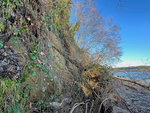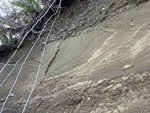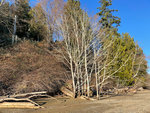



Agates and oysters. A clear tide. Stories.
I am south of Driftwood Annie’s point, strolling Pitt Passage with two veteran beach walkers. The going is wonderfully slow.
“It changes so much, you know,” says one of my companions. It is late winter and the rocks of the upper beach are wrinkled with long undulations that will disappear by spring. “Even just week to week, seems like. Or it’s your perception.”
Many of our beaches grow steeper in winter. Storms act as bulldozers. Our waves may not compare to ocean waves, but they are enough to send rocks scurrying; sand rises and falls through the seasons like the tide itself. We pass a row of abandoned pilings. Another beach walker, coming the other way, says that to him these pilings lean more every year.
Beaches are aikido masters. Everything on them is loose. By transferring the violent energy of waves into individual rocks that then jump, tumble, heap and fall, they prove that it is in fact possible to dissipate violence rather than pass it on to the next guy or magnify it through generations. But — and this is a big but — to achieve such a feat, you cannot remain unchanged.
As in aikido, you must realign yourself along the path of the incoming energy and contort yourself to direct it safely toward dissipation. I’m thinking of friends I have helped through trauma. It’s not something you can do dispassionately. The trauma flows through you as you help them seek release; it transforms everything it touches.
Nature teaches that transformations need not be feared. If anything is to be feared, it is the thing that proclaims itself unchanging. All around me is anatomy of the beach’s latest contortions. It makes for unstable walking. Is it any surprise that anything solid here, piling or bluff, will eventually fall?
Farther down the beach we come to a terrain of crumbling bluffs. They are case studies in what geologists call punctuated equilibrium. Things stay the same for a long time, years or millennia, before change comes as fast as a punctuation mark. True for dinosaurs and true for these steep scarps of packed sand. Imbricated in their faces are layers of rock cobbles. We step around blocks of fallen sand into glistening alcoves to see treasures that have been borne and buried by long-lost glaciers and are now brought to light by waves. Above, trees lean like the hands of a hundred drunken clocks. Over decades, the bluff beneath them slumps with small landslides. Some trees sink into the beach, getting a new foliage of seaweed, while others hang on and manage to return their growth to vertical. On the elbow in one we spy a sapsucker.
This is where our beaches are born. Our geology is unique enough that research on its interactions with the sea has coined a new geological term: feeder bluff. So called because they feed Puget Sound’s beaches with the rocks and sand they need to exist and perform their aikido, feeder bluffs are scattered from Neah Bay to Olympia. The Key Peninsula has more than most South Sound shorelines.
Up and down the peninsula are dozens of cells of sediment movement. Sediment in the form of sand and rock enters a beach from a feeder bluff. Waves push the sediment in punctuated pulses along shore until it reaches a bend in the shoreline and settles. Look at a map and notice where sand spits appear. Imagine how sand moves.
A recent mapping project, available on the Department of Ecology website, shows the part in this process — feeder bluff, transport zone, deposition zone — played by every stretch of beach in Washington. For any beach you walk you can learn the source and destination of its sediment.
It’s not an exaggeration to say that without feeder bluffs, the beaches we know would slowly vanish. Scientists estimate that 90% of Puget Sound’s sediment comes from eroding bluffs and only 10% from rivers and streams. Rivers carry far more clay and silt than sand and rocks. Without our unique array of feeder bluffs, Puget Sound would probably be carpeted with thick and sticky muck rather than the rocks of every hue we know and love, especially in its convoluted southern reaches.
Scientists are documenting this now where bluffs have been armored with bulkheads to protect yards and homes from landslides. (As my old hydrology professor would have said: “That’s not a landslide problem. That’s a building problem. A building-a-house-where-a-landslide-will-happen problem.”) Starved of sediment by bulkheads, beaches grow narrow and muddy. Waves come in more strongly and they are not dissipated but reflected by the bulkhead back into the water, where they cross threads with other waves and stir up a mess of ill energy.
Where I live the property owners worry about a sand spit that carries in its sediment layers of cook pits and canoe launches that go back centuries. Sea level creeps higher. Large driftwood has become a rarity. Plans have been floated to anchor logs atop the sand spit to help it stand firm. I once shared their fear but now I’m not so worried. I don’t see the spit as a static thing.
Maybe it comes from spending time with folks like my companions today. Beach walkers are a particular breed with a gaze that roves from individual rocks and bits of glass to cloud formations and wave patterns. Though they walk the same stretches of beach every week, they expect to find something new every time. They have been trained by subtle rearrangements, glinting oddities, the way distant influences appear within upheaval — the alignments left by passing traumas.
Beaches of loose rock can be buoyant. They can erode fear if you let them. Just south of my local sand spit is a quarter mile of mostly unarmored bluffs, and winter after winter as I have seen them crumble, my worries have been eased. As sea level rises, waves will lick those bluffs more and more often, providing that particular cell with larger and larger slides of sediment. Provided the bluffs are not armored, perhaps it will be enough to keep the spit’s head above water.
At the farthest point on our walk, we come to the edge of a stunning natural amphitheater. The beach curves below a hundred vertical feet of sediment that has been falling in sheets and fans. The statewide mapping effort has a special term for such outsized bluffs: “feeder bluff exceptional.” This is one of 15 on the Key Peninsula. It feels like a place where the world is being created. I think I might need to make a pilgrimage to each.
UNDERWRITTEN BY THE FUND FOR NONPROFIT NEWS (NEWSMATCH) AT THE MIAMI FOUNDATION, THE ANGEL GUILD, ADVERTISERS, DONORS AND PEOPLE WHO SUPPORT INDEPENDENT, NONPROFIT LOCAL NEWS